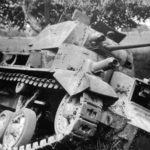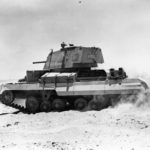Italian A9, North Africa 1941
Damaged A9 CS, France 1940
Abandoned A9, France 1940
A9 of the 6th Battalion RTR, North Africa 1940-41
A9 “Arnold” T3521 of 1st Battalion RTR, North Africa
Scammell Pioneer tank transporter named “Snow White” with A9 tank, 1941
Mack EXBX 18-ton 6×4 tank transporter with Cruiser Mk I CS, A9 tank
Destroyed A9, North Africa
A9 of the 1st Armoured Division 2nd Armoured Brigade
Abandoned A9 tank Calais 27 May 1940
Cruiser tank Mk I A9 and wehrmacht radio team
British tank A9 cruiser Mk I CS
Tank A9 Cruiser Mk I
A9 was designed by Sir John Carden in 1934, as the successor Vickers Mark II. Trials started in 1936, and production in 1937. 125 tanks were built in total, and saw service from 1938-41. It was the first British tank fitted with a central turret, but it was not particularly successful design or modern, and the tank was very poorly armored (only 14 mm). The weight of the A9 being relatively low allowed it to be powered by a commercially available 9.64 litre AEC bus engine, which gave it a top speed of
40 km/h. It also had a distinctive “slow-motion” suspension system with the triple-wheel bogies on springs mounted with Newton hydraulic shock absorbers. It was armed with a 40 mm (2-pdr) main gun and three machine-guns, one coaxial in the main turret and the other two in separate auxiliary turrets, and it was the first British tank with an hydraulic-powered turret traverse.
Combat experience in France in 1940 and North Africa proved that the design had critical drawbacks: it was just too slow, mechanical unreliability and thinly armoured when confronted by contemporary German tanks.
Specifications:
version | Cruiser Tank Mk I, A9 |
crew | 6 |
armor | hull:5 – 14 mmturret:4 – 14 mm |
main armament | 2pdr OQF (40mm) 100 rounds |
secondary armament | 3 x Vickers 7,92 mm, 3000 rounds |
weight (kg) | 13000 |
length (mm) | 5791 |
width (mm) | 2501 |
height (mm) | 2653 |
engine | AEC Type 179, 150 hp at 2200 rpm. 6 cylinder, liquid cooled, gasoline |
range on road (km) | 241 |
speed (km/h) road/off road | 40/24 |
trench crossing (mm) | |
vertical obstacle (mm) | 610 |
fording ability (mm) | 910 |
serial numbers | T3493 – T 3542 and T7196 – T7270 |
Source:
Peter Gudgin: Armoured Firepower: The Development of Tank Armament, 1939-45
George Forty: The World Encyclopedia of Tanks












